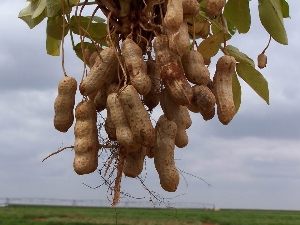Madison, Wisconsin, USA
July 12, 2011
 Peanut production in the U.S. is primarily targeted towards the candy industry and for the production of peanut butter. Velencia peanuts, one of the major market type peanuts in the country, are mainly grown as an in-shell peanut and are desired by the candy industry due to their distinct sweet flavor. This type of peanut is predominantly grown in eastern New Mexico and west Texas under irrigated conditions.
Peanut production in the U.S. is primarily targeted towards the candy industry and for the production of peanut butter. Velencia peanuts, one of the major market type peanuts in the country, are mainly grown as an in-shell peanut and are desired by the candy industry due to their distinct sweet flavor. This type of peanut is predominantly grown in eastern New Mexico and west Texas under irrigated conditions.
Most of the irrigation water in this region comes from the Ogallala aquifer. This aquifer is vital for the Southern High Plains, an area receiving only 450 mm rainfall per year with an evaporation rate greater than 2,000 mm per year. It is estimated that the aquifer could be depleted within 30 to 40 years. Farmers need peanut cultivars that mature early and produce greater yields with less use of water to continue growing peanuts in this region in the future.
Because genebanks around the world have such large collections of peanut genetics, it is unmanageable for an organization to screen the collections for useful traits. The development of core collections (10% of the total collection), which capture ~80% of genetic variability in the entire collection, has been suggested as a powerful strategy for providing crop breeding programs with useful genetic resources.
Researchers at New Mexico State University (NMSU) and the International Crop Research Institute for the Semi-Arid Tropics (ICRISAT), India developed a core collection specific to the Valencia peanut, representing genetics from 15 countries. The full results from this study can be found in the May-June 2011 issue of Crop Science.
Further collaborative research involving scientists from three US universities (NMSU, Texas A&M, Texas Tech), the USDA-ARS Cropping System Research Lab. at Lubbock, Texas, the ICRISAT, and the National Semi-Arid Resources Research Institute (NaSARRI), Uganda was conducted. Scientists were able to place large amounts of genetic information from all over the world into five distinct groups, allowing researchers to determine which locations are most important to maintain genetic diversity for the Valencia peanut.
This research was supported in part by National Peanut Board, New Mexico Peanut Research Board, New Mexico Agricultural Experiment Station, USDA-ARS, and USAID-Peanut CRSP through the University of Georgia.
Naveen Puppala, who leads the group at NMSU and collaborates with US Universities/USDA-ARS, ICRISAT, and NaSARRI, believes that this partnership approach will help address significant agricultural problems for peanut farmers around the world.
The full article is available for no charge for 30 days following the date of this summary. View the abstract at https://www.crops.org/publications/cs/articles/51/3/1089.